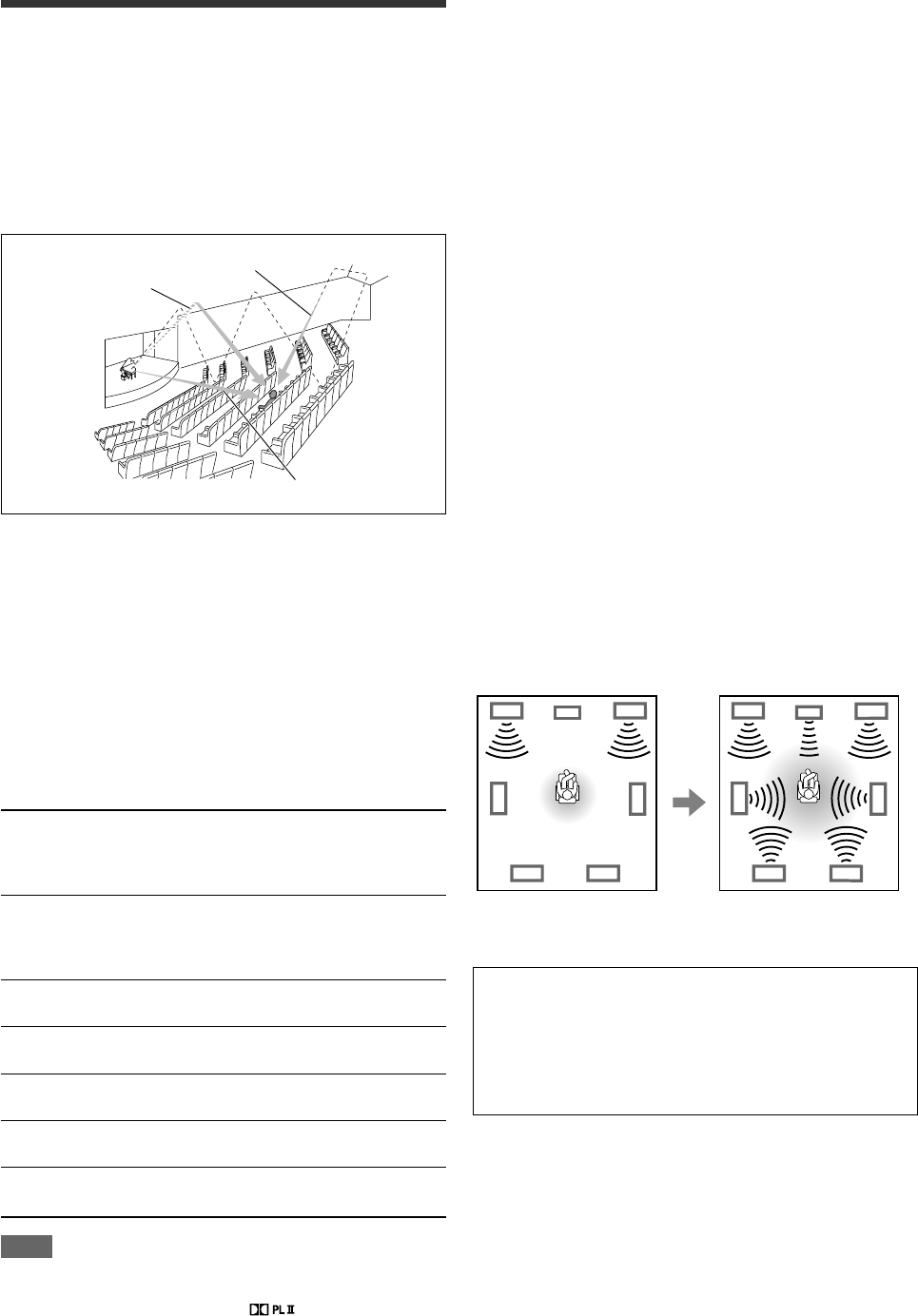
48
Introducing the DSP modes
The sound heard in a concert hall, club, etc. consists of direct
sound and indirect sound—early reflections and reflections from
behind. Direct sounds reach the listener directly without any
reflection. On the other hand, indirect sounds are delayed by the
distances of the ceiling and walls. These direct sounds and
indirect sounds are the most important elements of the acoustic
surround effects.
The DSP modes can create these important elements, and give
you a real “being there” feeling.
The DSP modes include the following modes:
• Digital Acoustic Processor (DAP) modes—HALL1, HALL2, LIVE
CLUB, DANCE CLUB, PAVILION, THEATRE1, THEATRE2
• MONO FILM—Used for all types of 2-channel signals (including
Dual Mono signal)
• All Channel Stereo mode (ALL CH STEREO)
When one of the DSP modes is activated, the DSP indicator lights
up on the display.
■ Digital Acoustic Processor (DAP) modes
You can use the following DAP modes in order to reproduce a
more acoustic sound field in your listening room.
HALL1 Reproduces the spatial feeling of a large
shoebox-shaped hall designed primarily for
classical concerts. (Its seating capacity is about
2000.)
HALL2 Reproduces the spatial feeling of a large
vineyard-shaped hall designed primarily for
classical concerts. (Its seating capacity is about
2000.)
LIVE CLUB Reproduces the spatial feeling of a live music club
with a low ceiling.
DANCE CLUB Reproduces the spatial feeling of a rocking dance
club.
PAVILION Reproduces the spatial feeling of an exhibition
hall with a high ceiling.
THEATRE1 Reproduces the spatial feeling of a large theatre
where the seating capacity is about 600.
THEATRE2 Reproduces the spatial feeling of a small theatre
where the seating capacity is about 300.
NOTE
When “THEATRE1” or “THEATRE2” is activated while playing
back 2-channel analogue or digital source, the built-in Dolby Pro
Logic II decoder is activated and the indicator lights up.
Early reflections
Direct sounds
Reflections from behind
When using the DAP mode, the sounds come out of all the
connected and activated speakers.
• If “SURROUND SPK” is set to “NO” in the speaker setting
(see page 28), JVC’s original 3D-PHONIC processing (which
has been developed to create the surround effect through the
front speakers only) is used.
The 3D-PHONIC indicator lights up on the display.
■ MONO FILM
In order to reproduce a more acoustic sound field in your listening
room while viewing monaural sound video software (analogue
and 2-channel digital signals including Dual Mono signal), you can
use this mode.
The surround effect will be added, and the sound localization of
actor’s words will be improved.
This mode cannot be used for multi-channel digital signals.
When “MONO FILM” is used, sounds come out of all the
connected (and activated) speakers.
• If “SURROUND SPK” is set to “NO” in the speaker setting
(see page 28), JVC’s original 3D-PHONIC processing (which
has been developed to create the surround effect through the
front speakers only) is used.
The 3D-PHONIC indicator lights up on the display.
• If incoming signals change from 2-channel digital signal to
another digital signal type, “MONO FILM” is canceled and an
appropriate Surround mode is activated.
■ All Channel Stereo mode (ALL CH STEREO)
This mode can reproduce a larger stereo sound field using all the
connected (and activated) speakers. This mode cannot be used
if “SURROUND SPK” is set to “NO” in the speaker setting
(see page 28).
Sound reproduced from
normal stereo
Sound reproduced from All
Channel Stereo mode
3D HEADPHONE mode
If you connect a pair of headphones while one of the
Surround/DSP modes is in use, the 3D HEADPHONE mode is
activated without respect to the type of software played back.
“3D HEADPHONE” appears on the display and the DSP and
HEADPHONE indicators light up.
46-50RX-D701S[B]_f.p65 05.11.7, 2:54 PM48


















